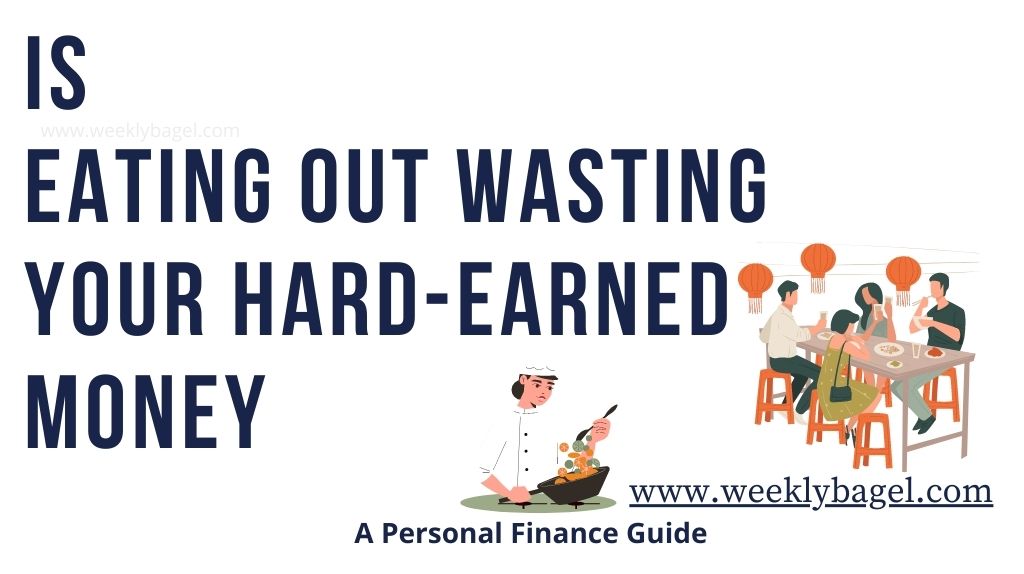
With the quick delivery services and rampant fast foods nowadays, it is easier not to spend time cooking at home. As a result, only about 10% of Americans love cooking at home according to a Harvard Business Review survey. This affects the economy positively, since the other 90% supposedly love eating out.
For working class young adults, this is very bad. This is because eating out is one of the biggest waste of money in your budget. Restaurants and fast foods costs tend to accumulate a lot in a month. Hence, why they could disrupt your savings.
When I write about eating out, I do not refer to the foods alone. The daily cups of fast food coffee can accumulate to a great deal of money too. This is especially brand fast foods. Fast food is a waste of money.
Below is what the average American spends eating out.
How much does the average person spends on eating out
The average American eats out often.
According to Motley Fool, the average American spends about $37 weekly on food delivery. He or she orders more than 59 food deliveries annually. Therefore, spending too much money eating out.
This can create a serious dent on any average working class adult savings, if you consider what an average of $37 weekly amounts in a year. Let us work it out.
You have 52 weeks in a year, multiple by $37 weekly. In a year, the average American spends about $1924 annually due to weekly deliveries alone. There is no reason why anyone making less than $30 per hour should be spending this amount eating out.
Here is what else you need to know.
What Age Eats Out the Most
A Yahoo Finance survey categorizes this by income and age. While adult Gen Z’s spends an average of $53 weekly on eat outs, Millennials average $75 a week. You would think being older makes you conservative about money, but it does not.
In addition, salary has nothing to do with the age that eats out the most. Here is what I mean.
Working class adults with annual salaries of $50,001 to $60,000 eat out 4 times a week. This is in contrast to $40,001 to $50,000 annual earners. The latter spends an average of $117.82 eating out in restaurants and fast foods weekly.
As you can see, this is more likely due to other reasons than age or salary factors. Life and social engagement could be factors contributing to these expenses. This is in addition to one’s wants and extra-curricular activities which involve eating out in a restaurant.
Now, does that mean one should stop eating out to save money?
No, my dear reader. As a working adult, our social life warrants hanging out with friends and having a good time outside of work and family responsibilities. This may mean eating out in restaurants and fast foods.
So, it is inevitable not to eat out sometimes. With that said, here are ways to limit your takeout expenses when life calls for it.
How You Could Limit Your Eating Out Expenses
You can really save money by not eating out, but since it is inevitable at one point, do one of these to limit eat out expenses.
1. Spend Within A Budget Limit
A while ago, I discussed the importance of using a budget to control your monthly expenditures. Just how much of your budget should go to eating out, my good reader?
Your monthly eat out expenses should be less than 10% of your monthly budget. This is because eating out is one of the biggest waste of money in your budget. Eating out could waste your hard-earned money.
Therefore, a budget can restrict this kind of expenses by assigned a fixed budget to it. When you set your budget for the month, assign a specific amount to your eat-out expense. Make sure you stick with this budget.
What this does for you, is to reduce spending on takeouts. This is by making sure you do not spend more than the amount you already assigned for the month. Do you understand?
If you do not know how to create a personal budget for yourself, follow the blue highlighted to read my article on it.
2. Use the Once-A-Week Rule
Since not dining out is not an option due to our wants, friendships and social requirements, you can use the once-a-week rule to save money. What is the once-a-week rule?
The once-a-week rule is a rule I created for dining out with my friends. It dictates how often you should eat out in a week. This is especially in restaurants which could stretch your eat-out budget.
Use this rule to save money. Will this ruin your friendships?
As a rule of thumb, your friends are supposed to understand when you are on a budget. If not, you may have expensive friends who contribute to your monthly expenses. Read my article- Do your friends Cost You Money, for ways of dealing with this issue.
Anyways, you can always invite your friends to your place to cook. I do this, whenever I have exceeded the once-a-week rule. It will save you money, while creating a closer and deeper connection since it is a tête-à-tête meal.
3. Curb Your Coffee Habits
Coffee is one of the most consumed beverages in the United States. According to Yahoo Finance, Starbucks alone has made about $21.38 billion per year selling coffee. Guess who contributes to this revenue?
The working class adults like you and me. Oh yes- I am guilty sometimes.
Anyhow, brand coffee products are very expensive. Coffee prices may range from $2 per cup to a whopping $5. For every day coffee drinkers, this can quickly accumulate to an average of $60 to $150 monthly.
Now, this is a calculation based on one cup of coffee per day. There are people out there who drink more than one cup daily. In their case, the daily and monthly expenses are higher than what I have calculated here.
You can avoid this expenses, when you buy and make your own coffee. Nowadays, you can buy insulated cups to keep your home brewed coffee warm for hours. You can save by not buying coffee outside your home.
Check out further ways to save money on coffee to practically eliminate this kind of eat-out expense.
4. Cooking More At Home
Eating out is a waste of money. From what I have written so far, I am sure you are able to discern you can save eating at home vs eating out.
Sometimes, cooking at home may seem like a hassle due to the time and energy it takes. I can assure you it is not. In fact, you can easily get pre-made frozen meals from grocery stores.
All you have to do, is to use a microwave to warm them and eat. In grocery stores, some of these meals cost about $1 to $4 as compared to paying a higher amount for the same meal in a restaurant or a fast food.
5. Stop Buying Lunch At Work
Your workplace can eat into your monthly income, if you buy lunch at work. This is because you are there more than half the days in a week. Therefore, you spend a lot to sustain yourself each time you are at work.
Have you noticed how a bottle of water in a workplace cafeteria cost about $1.50, while a large grocery store sells a pack of 24 bottles for $3.25?
This is a complete rip off. You can save a lot of money by bringing in your own bottle water from home. Now, imagine paying about $10 for crappy-tasting breakfast and lunch every single day you go in for work while drinking an outrageously priced bottle water.
Unless your workplace cafeteria cooks top-notched foods, it is not worth the expenses. Is it now, dear reader?
This is why eating out is a waste of money, especially at work. It is how eating out keeps you poor. You can save by bringing your lunch from home. Not only will you control this expense, but also you can make your food the way you like it.
To conclude this article, the average cost of eating out per month for one person is a lot. Try to imagine how much you can save in a year, when you avoid takeouts and eating out. Eating out is a waste of money.
And, you can save hundreds of dollars annually by limiting your eating out expenses.




 Opening A Bank Account: What You Need To Know
Opening A Bank Account: What You Need To Know